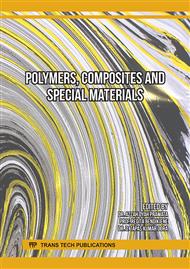p.3
p.9
p.15
p.25
p.33
p.45
p.55
p.61
Incorporation of Bottom Ash as Aggregates in High-Volume Fly Ash (HVFA) Concrete
Abstract:
Research has been conducted on the utilization of coal combustion residues, specifically fly ash and bottom ash, in order to produce concrete products that meet national standards. Fly ash is employed as a high-volume replacement for cement in what is known as high-volume fly ash (HVFA) concrete. On the other hand, bottom ash is used as both fine and coarse aggregates, serving as a substitute for sand in the concrete mixture. Various characterizations were performed, encompassing the examination of the constituent minerals, crystallinity levels of bottom ash, water absorption, porosity, abrasion resistance, compressive strength, and morphological properties of the concrete specimens. Both fly ash and bottom ash exhibit significant proportions of SiO2, Al2O3, Fe2O3, and CaO, which possess pozzolanic properties and contribute to the compressive strength of the concrete. Concrete samples were produced with varying amounts of bottom ash and other ingredients according to the mix design. The highest compressive strength achieved after 28 days of curing was 27.57 MPa (designated as code B5), accompanied by the lowest porosity of 6.25%. Specimens with code B5 also displayed the lowest abrasion rate of 0.02 mm/minute and water absorption of 1.1%. These results suggest that the formulated mixture has the potential for developing concrete products suitable for walls and paving, adhering to the requirements specified in standard SNI 03-0349-1989 and SNI 03-0691-1996.
Info:
Periodical:
Pages:
25-32
Citation:
Online since:
November 2023
Keywords:
Price:
Сopyright:
© 2023 Trans Tech Publications Ltd. All Rights Reserved
Share:
Citation:



